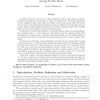Free Online Productivity Tools
i2Speak
i2Symbol
i2OCR
iTex2Img
iWeb2Print
iWeb2Shot
i2Type
iPdf2Split
iPdf2Merge
i2Bopomofo
i2Arabic
i2Style
i2Image
i2PDF
iLatex2Rtf
Sci2ools
ADHOCNOW
2004
Springer
2004
Springer
Analysis of the Information Propagation Time Among Mobile Hosts
Consider k particles, 1 red and k −1 white, chasing each other on the nodes of a graph G. If the red one catches one of the white, it “infects” it with its color. The newly red particles are now available to infect more white ones. When is it the case that all white will become red? It turns out that this simple question is an instance of information propagation between random walks and has important applications to mobile computing where a set of mobile hosts acts as an intermediary for the spread of information. In this paper we model this problem by k concurrent random walks, one corresponding to the red particle and k − 1 to the white ones. The infection time Tk of infecting all the white particles with red color is then a random variable that depends on k, the initial position of the particles, the number of nodes and edges of the graph, as well as on the structure of the graph. In this work we develop a set of probabilistic tools that we use to obtain upper bounds on the...
| Added | 30 Jun 2010 |
| Updated | 30 Jun 2010 |
| Type | Conference |
| Year | 2004 |
| Where | ADHOCNOW |
| Authors | Tassos Dimitriou, Sotiris E. Nikoletseas, Paul G. Spirakis |
Comments (0)

